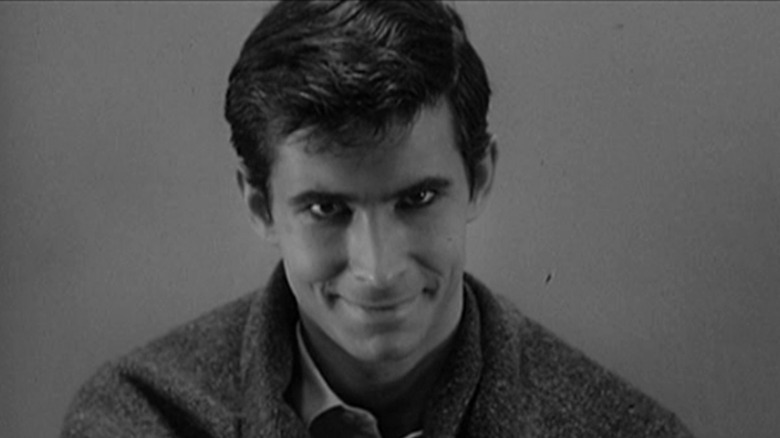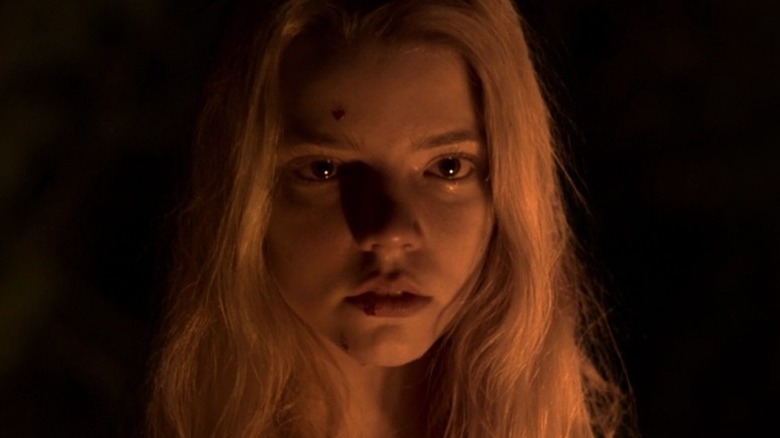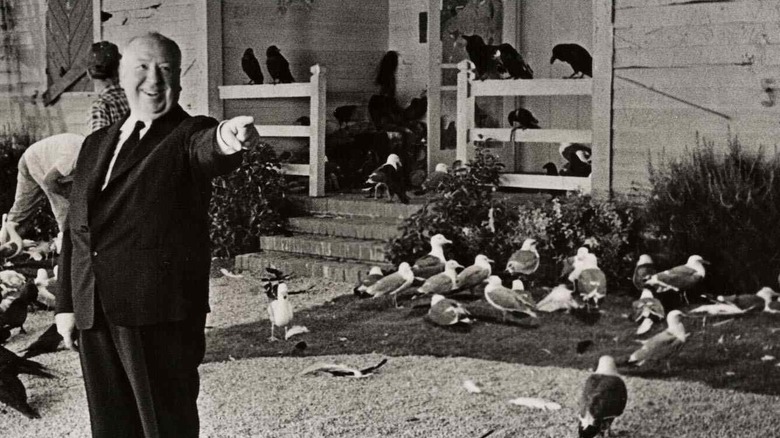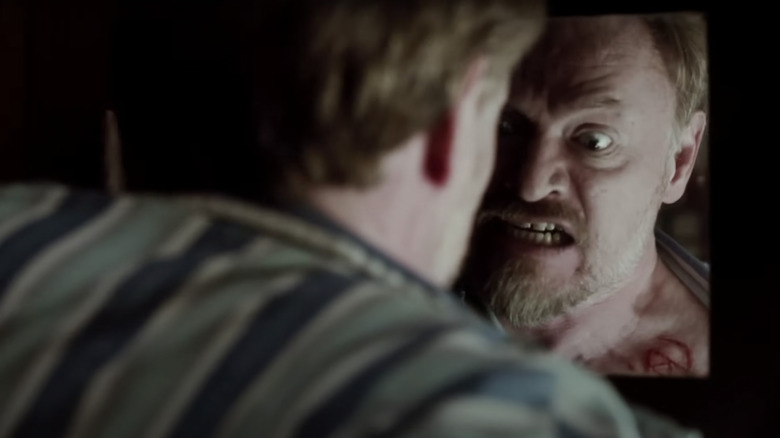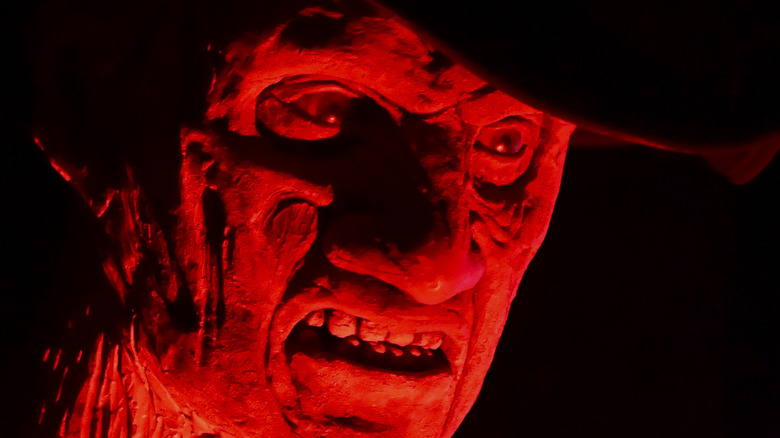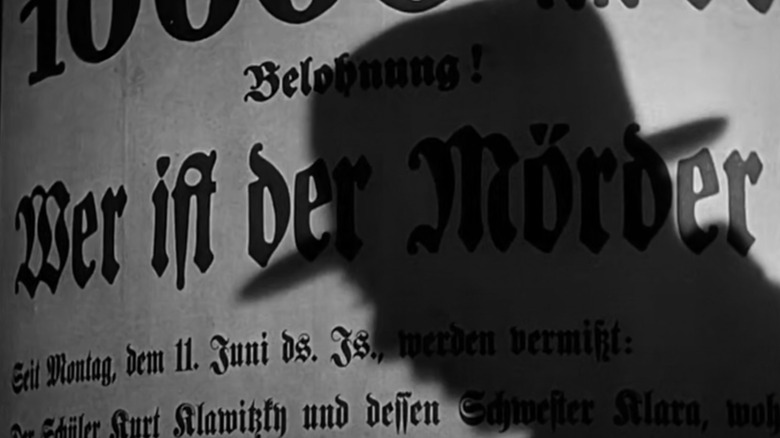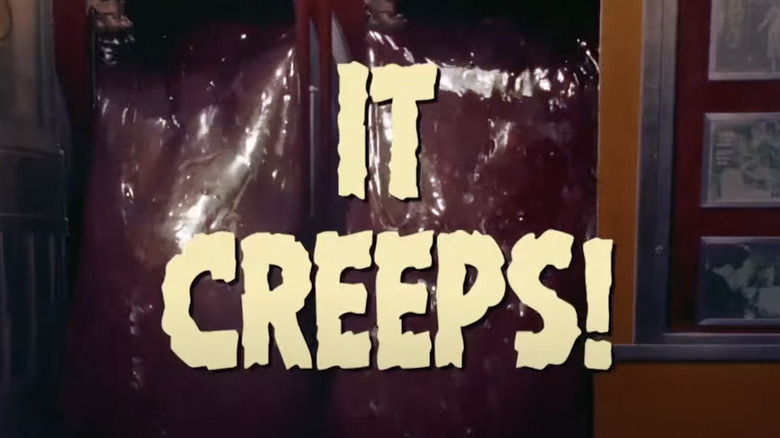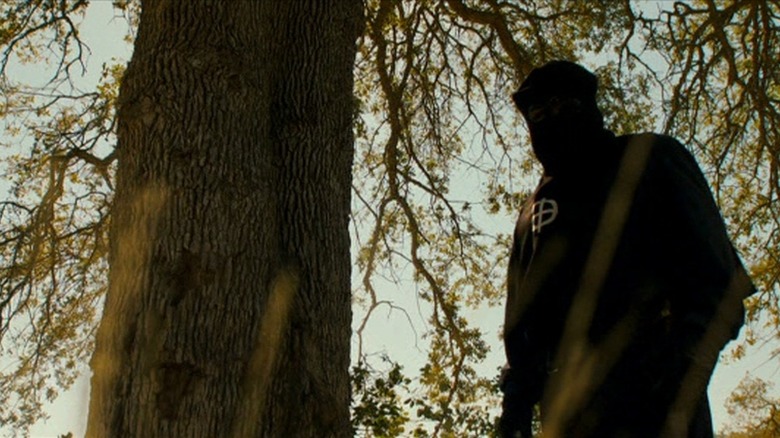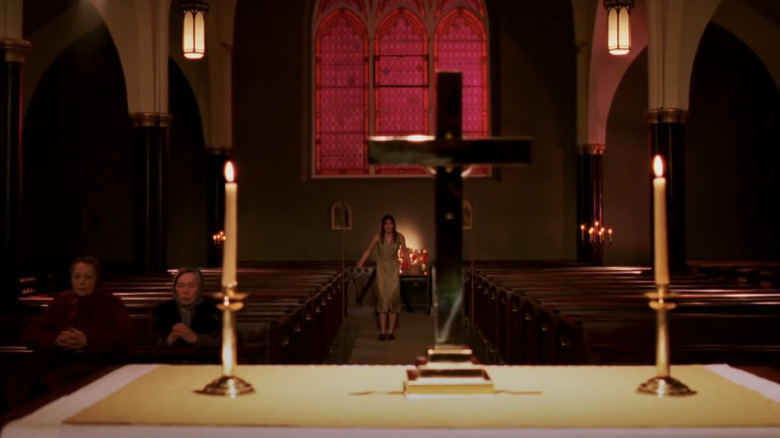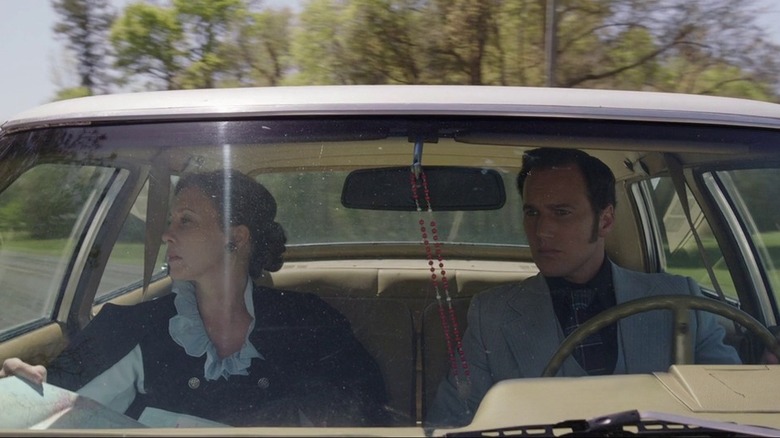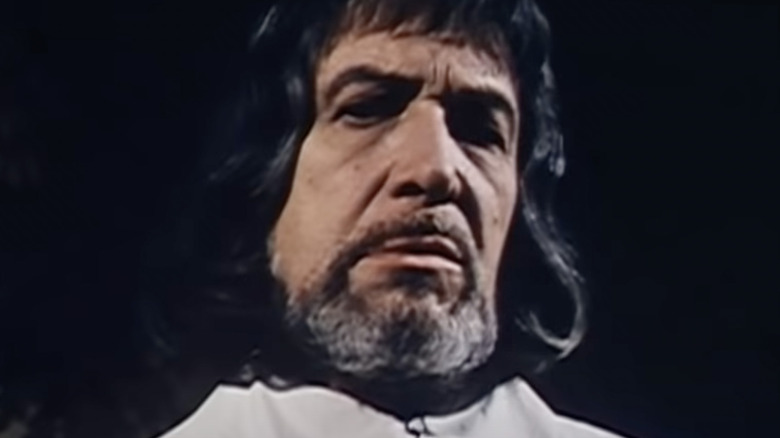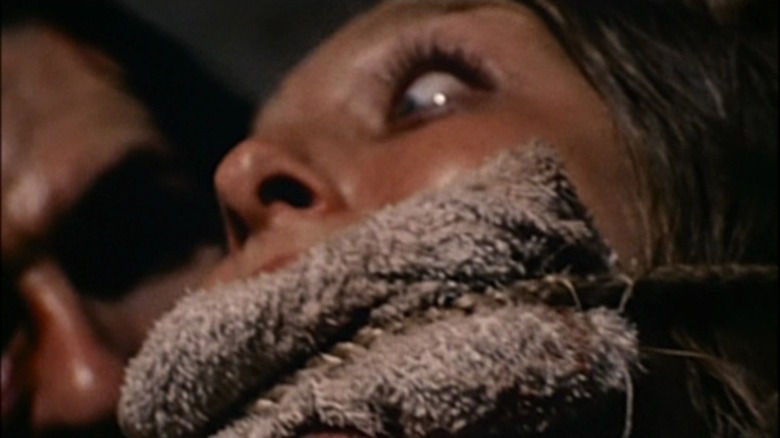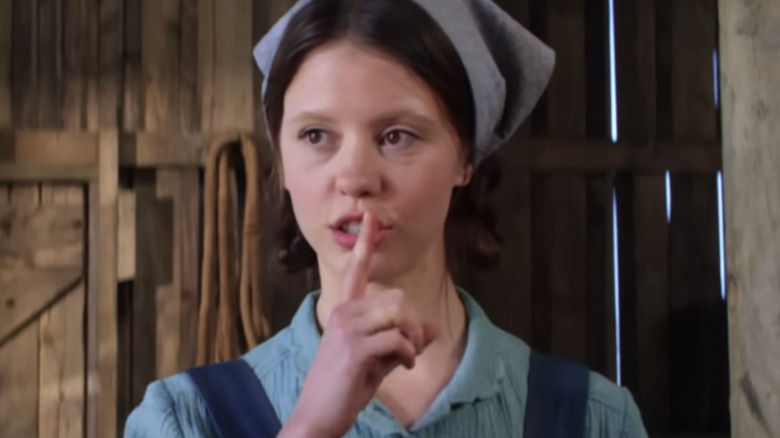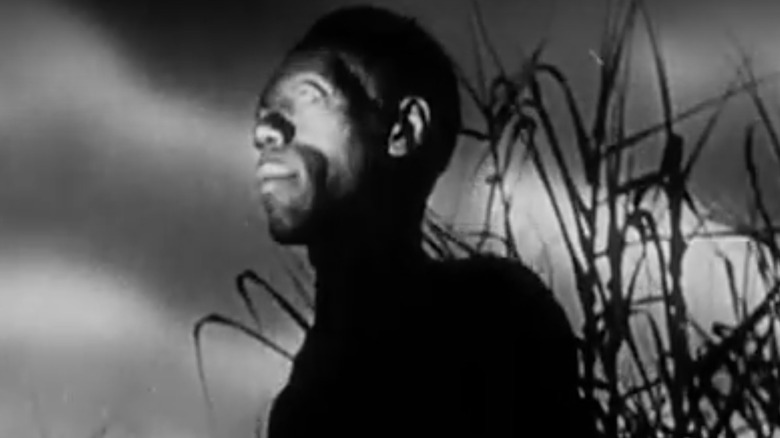Horror Movies That Have A Real Life Inspiration
"Based on a true story" is a familiar phrase that sometimes appears onscreen before a movie officially starts. In horror films the phrase is usually designed to add to the creepy atmosphere. What could be more chilling than the idea that the terrifying events on the screen actually happened?
Some horror films promote themselves as being based on a true story as a way of adding to the creepiness of the experience. As noted by Esquire, this was particularly popular with found footage movies before they became an established part of the genre. Many viewers who saw documentary-style horror movies like 1980's "Cannibal Holocaust" and 1999's "The Blair Witch Project" actually believed that they were watching something real. Sometimes, however, the "inspired by true events" label is true.
Many horror films use real-life inspirations to make their stories more believable and frightening. As detailed by Skeptical Inquirer, a few, like "The Amityville Horror," are inspired by hoaxes that almost fooled the world. Some, like "The Witch," weave accurate historical details with traditional folklore, as described by Slate. Others, like "Zodiac" and "M," may be works of fiction, but the hideous crimes depicted in them are real.
The Witch (2015)
Many horror movies claim to be based on true stories, but few can say that their dialogue comes straight from history. As stated by a title card before the credits, a lot of the film's script came directly from diaries and court records from the era when the film is set.
The family depicted in "The Witch," including the protagonist Tomasin, are entirely fictional, but as described by Time Magazine, they are still based on something real. Filmmaker Robert Eggers, who wrote and directed "The Witch," dedicated years to researching what it would be like to live in 17th-century America. Everything from the way the characters speak to what they wear was painstakingly crafted to immerse the audience in the era.
As detailed in an interview with Slate, Eggers explained that while the film is full of the supernatural, the depiction of witchcraft in the film comes directly from the beliefs of 17th-century Puritans. For instance, it was widely believed that witches would cause farm animals' milk to run dry and feed animal familiars from their own bodies, and in "The Witch," the Puritan stories are true.
The Birds (1963)
In Alfred Hitchcock's classic horror film "The Birds," all of the birds living in the California town of Bodega Bay inexplicably attack, killing townspeople and sending the community into a panic. As described by Turner Classic Movies, the film offers no explanation for why the birds suddenly turn on the humans. In the town of Capitola, California, birds really did suddenly attack, but unlike in "The Birds," we now know why.
As described by The Mercury News, Hitchcock was inspired to direct "The Birds" after learning about an event that happened in the summer of 1961. Without warning, flocks of birds coming in off the ocean smashed into homes and cars, often vomiting. Many died or were stunned when they struck buildings, leaving the streets of Capitola littered with dead and dying birds. At the time, the only explanation residents had was that the birds had been disorientated by the fog.
In reality, the bizarre event was likely caused by a toxic algae bloom that created a neurotoxin called domoic acid. Eating contaminated fish causes vomiting and confusion in humans, and in animals, it can cause frenzied behavior and seizures.
The Amityville Horror (1979)
Many horror movies claim to have been inspired by true events, but few can claim to have been based on both a true story and a hoax. "The Amityville Horror," as described by Turner Classic Movies, follows the Lutz family as they move into a house where grisly murders took place years before and experience strange phenomena.
The murders described in the film actually happened. As stated by Rolling Stone, the backstory for the film's famous haunted house comes from a massacre committed by Ronald DeFeo, who killed six members of his family in 1974. The majority of the inspiration for the film came from the real-life Lutz family, who claimed to have experienced bizarre supernatural events. Today, their accounts of the events there are widely considered to be a hoax.
As detailed by Skeptical Inquirer, the Lutz family genuinely moved into the house where DeFeo committed his murders. They lived in the house for 28 days and claimed that during that time, they had a fly infestation, odd bruises, slime dripping from the ceiling, and their youngest daughter befriended a pig monster. Since then, much of the information from the Lutz account has been proven untrue. There are many factual errors in their story, and investigations have found that the author of "The Amityville Horror" book did little to fact-check their account and presented the mostly fictional story as a true account of hauntings and psychic events.
The Quiet Ones (2014)
The movie "The Quiet Ones" declares itself "inspired by actual events" (per Roger Ebert), although it stretches that description as far as it can go. The film depicts a strange experiment conducted by an unorthodox psychologist who believes that poltergeists, possession, and physical supernatural phenomena are caused by human beings with a treatable disorder. Although the events of the film are fictional, it was inspired by an even stranger experiment from the 1970s.
As detailed in "Conjuring Up Philip: An Adventure in Psychokinesis," a Canadian group interested in parapsychology invented a story about a ghost. The group believed that paranormal events and apparent ghost sightings were not due to interactions with the dead but instead were a result of some unknown supernatural power that came from the human mind. As seen in footage of the experiment and interviews with the participants, they created an entirely fictional ghost story and then attempted to make contact with the imaginary dead man through seances. They claimed that the experiment was a success and that they had heard unexplained tapping in the room and observed objects moving unexpectedly when participants were communicating with "Philip."
Nightmare on Elm Street (1984)
Wes Craven's "Nightmare on Elm Street" is one of the most popular horror films of the 1980s. The film follows several teenagers being stalked and murdered in their dreams by the monstrous Freddy Krueger. Despite the film's explicitly supernatural premise, the concept was actually inspired by a real phenomenon.
As described by History, Craven stated that he had read the story of a child who had survived the Cambodian genocide and feared sleep. According to Craven, the child died in his sleep, with no clear cause. If true, the boy was not the only one. Throughout the 1970s and 80s, dozens of Hmong refugees from Southeast Asia (particularly Laos) died unexpectedly in their sleep. The exact cause of these tragic deaths is still unknown, but the condition is now called sudden unexplained nocturnal death syndrome (SUNDS).
Many at the time suspected that exposure to chemical nerve agents could have led to their deaths, but medical professionals have stated that this doesn't explain why some young men affected died in their sleep in the United States, long after possible exposure. Some believe that the horrendous traumas endured by these refugees took a physical toll on the young men, ultimately killing them.
M (1931)
The 1931 Fritz Lang classic "M" depicts a terrifying man named Hans Beckert stalking and murdering young children. As described by Roger Ebert, the film and the killer at the center of it are fictional, but it was inspired by an actual serial killer who committed at least nine murders in 1929 known as the Düsseldorf Vampire.
As stated by Britannica, the Düsseldorf Vampire's real name was Peter Kürten. Kürten's crimes began before he was 10 years old — it is believed that he may have murdered two other children around his own age. He spent time in and out of prison throughout his early life. When he was in his 50s, he was executed for killing nine people and attempting to kill seven more, though Kürten himself claimed to have at least attempted many more sexually motivated murders. Kürten and his fictional counterpart Hans Beckert had a profound impact on how serial killers were understood by the public.
The Blob (1958)
"The Blob" arrived in theaters in 1958, introducing audiences to a rolling goo that consumes everything in its path, from people fleeing to entire buildings. As far-fetched as this beloved monster movie's premise is, it was actually inspired by something that witnesses claimed actually happened eight years earlier.
As recounted by Gizmodo, in the year 1950, two on-duty police officers in Philadelphia claimed that they saw something strange fall from the sky. When they found the thing that had fallen, they claimed that it was 6 feet across, purple, and glittered oddly while releasing vapor. When one of the men touched it, his hand allegedly got covered in a clear, sticky substance. The police called for backup, summoning more officers and even the FBI — but they claimed that within half an hour, the strange goo dissolved.
As described by Nerdist, although the discovery of the blob in the movie is very similar to the story told by the Philadelphia policemen, the filmmakers never outright confirmed that "The Blob" was based on the peculiar incident. However, as many involved with the production were from Pennsylvania, it's highly likely that they had heard the story.
Zodiac (2007)
"Zodiac," directed by David Fincher, tells the true story of the murders committed by a serial killer known only as the Zodiac Killer. As described by The Guardian, the film is not just inspired by real events but also makes a genuine attempt to depict historical events as they actually occurred.
"Zodiac" depicts the actual crimes committed in the 1960s and 70s, as well as the killer's communication with the police and press. The film's protagonists are Paul Avery and Robert Graysmith, both of whom actually worked for the San Francisco Chronicle at the time that the Zodiac Killer was sending letters to the press. Ultimately, the film presents suspect Arthur Leigh Allen as the most likely Zodiac Killer, which is still highly debated. The film is forced to invent some of the details because the Zodiac Killer has never been caught, but the majority of the movie's version of events is at least plausible, if not actually true.
The Exorcism of Emily Rose (2005) and Requiem (2006)
In 2005, "The Exorcism of Emily Rose" followed a fictional court case about a priest who accidentally killed a young woman during an exorcism. As described by Roger Ebert, the priest seeks to prove that Emily Rose was genuinely possessed by demons, making his actions justified. As described by The Guardian the following year, "Requiem" followed the grueling exorcism of a young woman named Michaela Klingler, who suffers from epilepsy. Although their central characters have different names, both films are based on the death of a real woman: Anneliese Michel.
As detailed by The Washington Post, in 1976, a German trial became a media sensation. Anneliese Michel, 23, had died, likely of starvation, while her family and several priests subjected her to dozens of repeated exorcisms. Michel had epilepsy and depression, and her family came to believe that she was possessed by demons. Her medical treatment was stopped, and Michel was slowly starved over almost a year of exorcisms performed by local priests. Although Michel weighed under 70 pounds at the time of her death, a doctor was never called. Michel's parents and two priests were convicted of manslaughter.
If you or someone you know is dealing with spiritual abuse, you can call the National Domestic Violence Hotline at 1−800−799−7233. You can also find more information, resources, and support at their website.
The Conjuring (2013)
The hit horror film "The Conjuring" launched a franchise based on the accounts of Ed and Lorraine Warren — a pair of self-proclaimed ghost hunters who appear as characters in the movie. The film's advertising described it as a depiction of real events. Per USA Today, the filmmakers were so devoted to accurately portraying the alleged haunting that they had 86-year-old Lorraine Warren consult on the film.
How truthful the film's depiction of the Warrens is has become the subject of controversy and a legal battle for the studio. As detailed in The Hollywood Reporter, reports that Ed Warren sexually abused a minor during the time when "The Conjuring" is set have led to a significant backlash against the franchise.
The Warrens' account of the story "The Conjuring" is based on is also suspect. In the film, the desperate Perron family seeks out the Warrens to help them rid their house of demons — but the reality that inspired the movie was different. As described in an interview with expert Joe Nickell for Skeptic, the Warrens actually turned up at the Perron house unexpectedly. As unusual as it sounds, the Warrens had a reputation for seeking out fellow Catholics and convincing them that their home had become full of demons. The Warrens have been able to effectively market the stories of these incidents extremely profitably.
If you or someone you know may be the victim of child abuse, please contact the Childhelp National Child Abuse Hotline at 1-800-422-4453 or contact their live chat services.
Witchfinder General (1968)
"Witchfinder General" is a beloved British film starring horror icon Vincent Price. While Price appeared in many campy and fun horror movies, "Witchfinder General" stands apart as a genuinely dark and disturbing film. Unlike "House on Haunted Hill" or "The Tingler," the villainous protagonist of "Witchfinder General" was a real person.
As described by History, Matthew Hopkins declared himself the Witchfinder General and wielded this fake authority by arriving in small villages, torturing and killing people he claimed were witches, and then demanding payment from the other townsfolk. As noted by Britannica, in total, it is believed that Hopkins killed at least 230 people between 1644 and 1647. The film depicts a fictional but plausible event, during which Matthew Hopkins arrives in a town, sexually assaults and tortures the people living there, and coerces them into giving him money to leave. While the film is incredibly dark, it does provide catharsis never achieved in reality: While in real life Hopkins died of tuberculosis, in the film he is violently dismembered.
If you or anyone you know has been a victim of sexual assault, help is available. Visit the Rape, Abuse & Incest National Network website or contact RAINN's National Helpline at 1-800-656-HOPE (4673).
Psycho (1960), The Texas Chain Saw Massacre (1974), and The Silence of the Lambs (1991)
Three of the most iconic killers in modern horror were inspired by the same real-life murderer: Ed Gein.
The first is Norman Bates, the apparently polite and anxious killer at the heart of Alfred Hitchcock's classic "Psycho." As described by Den of Geek, Robert Bloch wrote the novel that "Psycho" is based on while he was living very close to the area where Gein was arrested. Early reports about Gein's crimes, including that he was believed to have pretended to be his own mother, influenced the plot of "Psycho." The second is Leatherface from "The Texas Chain Saw Massacre," which was explicitly marketed as being inspired by a real crime. While Gein never used a chainsaw, filmmaker Tobe Hooper was inspired to create Leatherface's now iconic skin mask because of the grotesque ways that Gein used human skin. As described by Rolling Stone, the terrifying Jame Gumb from "Silence of the Lambs" was inspired by a number of real serial killers, but his desire to craft a suit that he could wear from the skin of his female victims was inspired by reports about Gein.
Pearl (2022)
"Pearl" is a prequel to the popular horror film "X." The film is set in the year 1918, and while the central character and the events in the story are the invention of filmmaker Ti West and actress and co-writer Mia Goth, a major part of the film is inspired by a real and genuinely horrific event: the Spanish Flu.
As described by The Guardian, although the film was very faithful to its early 1900s setting, it felt particularly timely for viewers in 2022 when it was released because of the COVID-19 pandemic. The epidemic dubbed "Spanish flu" infected approximately one-third of all people living on the planet and, per the CDC, killed at least 50 million. In "Pearl," the protagonist has become increasingly disturbed while in lockdown, and her frustration only grows as the rest of the world seems to be moving on from the pandemic, leaving her and her cautious mother behind.
I Walked with a Zombie (1943)
While the majority of the inspiration for the plot of "I Walked with a Zombie" comes from the classic gothic novel "Jane Eyre," the film also draws on some real-life inspirations. Though the island that the film is set on is fictional, the issues the imaginary culture grapples with are real.
As noted by Paste, there had been Hollywood films depicting voodoo and zombies before, but in general, they focused on the perceived exoticism of the subjects and made little attempt to make them believable. As described by an article published in the Irish Journal of American Studies, the film depicts a post-colonial society still haunted by the brutality and violence of slavery. While not always completely accurate in its representation of voodoo (as noted by Tor.com), the film does not depict the primarily Black characters who believe in it as superstitious or irrational. It is believed that the filmmakers did extensive research into representing the faith accurately and with respect and hired expert consultants to help them get it right.
